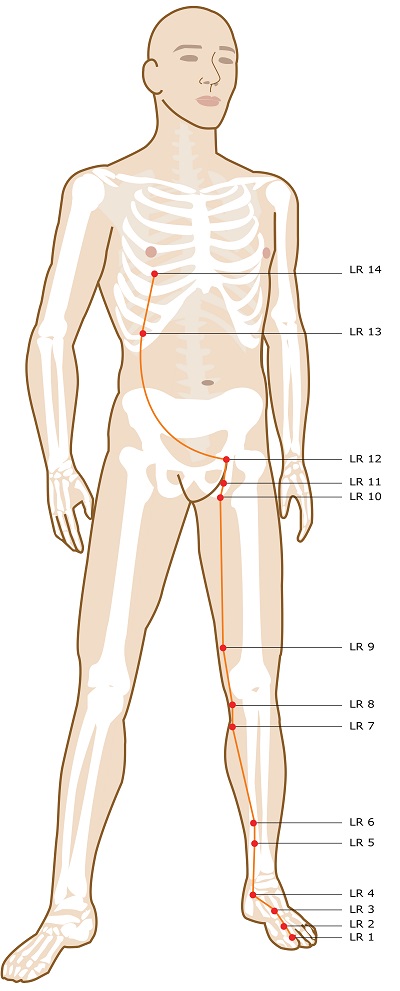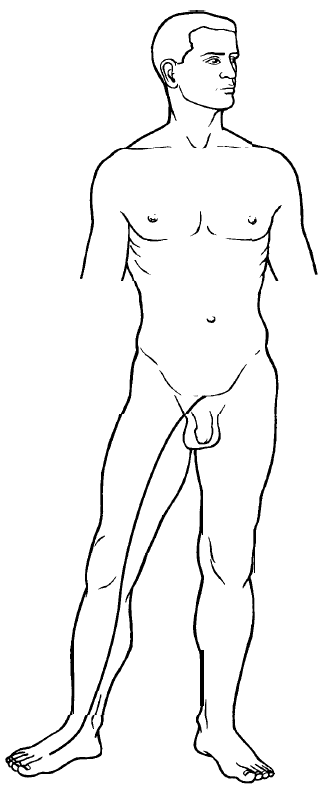Liver Meridian Acupuncture Points

Liver Meridian Points
- LR 1: da dun / Large Pile
- Function: Regulates menses, resolves damp-heat, promotes smooth flow of Liver Qi, restores consciousness.
- Indications: Hernia, enuresis, uterine bleeding, prolapse of the uterus, epilepsy.
- LR 2: xing jian / Moving Between
- Function: Clears Liver fire, subdues Liver yang, cools blood, subdues interior wind.
- Indications: None.
- LR 3: tai chong / Supreme Surge
- Function: Subdues Liver yang, expels interior wind, promotes the smooth flow of Liver Qi, calms the mind, calms spasms.
- Indications: Headache, dizziness and vertigo, insomnia, congestion, swelling and pain of the eye, depression, infantile convulsion, deviation of mouth, pain in the hypochondriac region, uterine bleeding, hernia, enuresis, retention of urine, epilepsy, pain in the anterior aspect of the medial malleolus.
- LR 4: zhong feng / Mound Center
- Function: Promotes the smooth flow of Liver Qi in the Lower Energizer.
- Indications: Hernia, pain in the external genitalia, nocturnal emission, retention of urine, distending pain in the hypochondrium.
- LR 5: li gou / Woodworm Canal
- Function: Promotes the smooth flow of Liver Qi, resolves damp-heat.
- Indications: Retention of urine, enuresis, hernia, irregular menstruation, leukorrhea, pruritus or itchy vulvae, weakness and atrophy of the leg.
- LR 6: zhong du / Central Metropolis
- Function: Removes obstructions from channels, promotes smooth flow of Liver Qi, stops pain.
- Indications: Abdomen and hypochondriac pain, diarrhea, hernia, uterine bleeding, prolonged lochia.
- LR 7: xi guan / Knee Joint
- Function: Frees channels and connecting vessels, disinhibits joints, dispels wind, relieves pain.
- Indications: Pain of the knee, especially if pain in on the inner knee.
- LR 8: qu quan / Spring at the Bend
- Function: None.
- Indications: Prolapse of uterus, lower abdominal pain, retention of urine, nocturnal emission, pain the external genitalia, pruritus vulvae, pain in medial aspect of the knee and thigh.
- LR 9: yin bao / Yin Bladder
- Function: Courses the Liver and rectifies Qi, adjusts the Penetrating and Conception vessels, clears and disinhibits the Lower Energizer.
- Indications: Pain in the lumbosacral region, lower abdominal pain, enuresis, retention of urine, irregular menstruation.
- LR 10: (zu) wu li / (Foot) Five Li
- Function: Soothes the sinews and quickens the connecting vessels, clears and disinhibits Lower Energizer damp heat.
- Indications: Lower abdominal distension and fullness, retention of urine.
- LR 11: yin lian / Yin Corner
- Function: Soothes the sinews and quickens the connecting vessels, regulates the Penetrating and Conception vessels.
- Indications: Irregular menstruation, leukorrhea, lower abdominal pain, pain in the thigh and leg.
- LR 12: ji mai / Urgent Pulse
- Function: Frees the channels and dissipates cold.
- Indications: Lower abdominal pain, hernia, pain in the external genitalia.
- LR 13: zhang men / Camphorwood Gate
- Function: Promotes the smooth flow of Liver Qi, relieves retention of food, benefits the Stomach and Spleen.
- Indications: Abdominal distension, borborygmus, pain in the hypochondriac region, vomiting, diarrhea, indigestion.
- LR 14: qi men / Cycle Gate
- Function: Promotes the smooth flow of Liver Qi, benefits the Stomach, cools blood.
- Indications: Hypochondriac pain, abdominal distension, hiccups, acid regurgitation, mastitis, depression, febrile diseases.
Primary Functions
- Maintaining the free flow of chi throughout the body.
- Dominating the sinews of the body.
- Influencing the health and function of the eyes.
- Controlling the health of the finger and toe nails.
Common Uses
- Resolving distension and pain related to the stagnation of Liver meridian chi, especially in the head, throat, chest, heart, lungs, stomach, abdomen, intestines, and genitals.
- Assisting the healthy movement of chi in the Stomach meridian, Lung meridian, and Spleen meridian.
- Treating the occurrence of headaches, dizziness, epilepsy, and spasms related to chi imbalances.
- Balancing the performance of Liver meridian chi.
- Improving the health of the eyes.
- Treating disorders that involve pain and swelling in the genitals, as well as genital issues such as ejaculatory disorders, priapism (unwanted erections), and impotence.
- Regulating the health of the menstrual cycle and improving menstrual disorders.
- Treating hernias, swelling, and pain, in the genital and lower abdomen areas.
- Treating urination disorders such as urinary retention, painful urination, urinary dysfunction in general, incontinence, frequent urination, and others.
- Treating lumbar (lower spine) pain.
- Improving psychological emotional disorders related to a failure in the Liver meridian chi.
Liver Meridian Channels & Sinews
The Liver meridian begins at acupoint LV1 on the side of the big toe.
From there, is ascends up the leg until it reaches the groin area, then bends sideways as it travels up the side of the torso and ends at LV14 on under the nipple on the chest.
But the Liver meridian, like all meridians, also has secondary pathways of energy that flow out from it that aren’t considered a part of the primary meridian line.
These secondary pathways don’t have acupuncture points of their own, but they are still an important part of the knowledge of trained acupuncturists because their energy flow helps explain why a certain meridian can influence body parts that don’t touch the meridian line itself.
Let’s take a look at these additional channels for the Liver meridian, as well as the muscle tissue known as the Liver channel sinews that are strongly affected by the flow of energy in the meridian.

Source: A Manual of Acupuncture
First up is the Liver luo-connecting channel which begins on the side of the ankle and travels up the leg.
This channel separates from the primary meridian at acupoint LV5 and ascends alongside the primary meridian until it reaches the groin area.
This channel opens into the genitals, which explains why the Liver meridian acupoints can be used to treat some genital disorders.
Along the way up the leg, the luo-connecting channel also connects with the primary Gallbladder meridian, closely tying the energy of the two meridians.

Source: A Manual of Acupuncture
Next up is the Liver divergent channel, also found on the leg alongside the luo-connecting channel and the primary meridian.
This energy pathway separates from the Liver meridian on the foot but not at an exact acupoint.
It ascends along the leg until it reaches the genital area, where it joins with the primary Gallbladder meridian near acupoint GB28.

Source: A Manual of Acupuncture
Finally, we have the Liver sinew channel, which is a group of muscle and tissue that follows the primary Liver meridian, the Liver divergent channel, and the Liver luo-connecting channel up the leg.
The sinew channel starts at the big toe and then rises up to connect with the medial malleolus (ankle bone), then connects with the medial condyle (knee bone), then finally continues upwards where it ends in the genital region and connects to other sinew channels from other meridians.
Related Pages
The 12 Primary Meridians
- Heart
- Pericardium
- Lung
- Spleen
- Liver
- Kidney
- Small Intestine
- Large Intestine
- Triple Energizer
- Stomach
- Gallbladder
- Bladder
